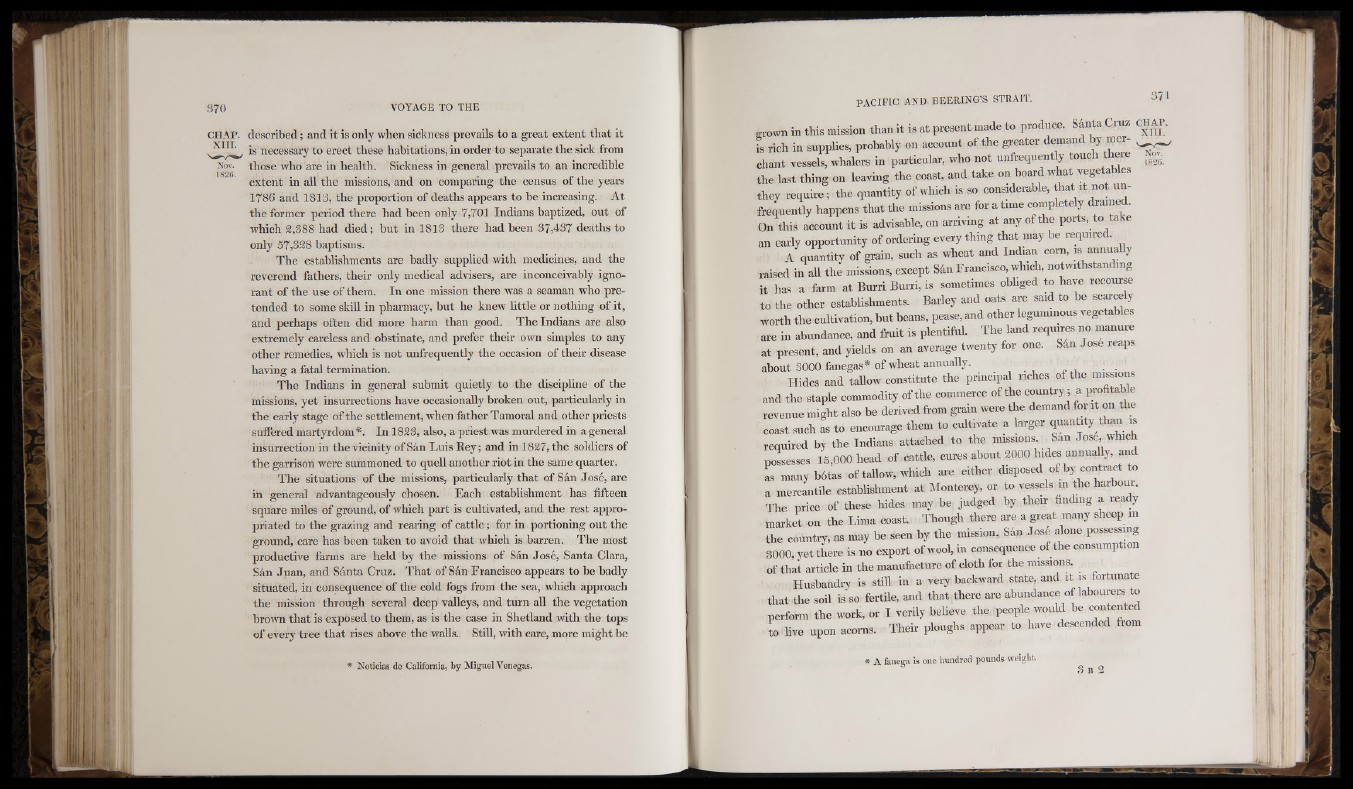
C H A P . described ; and it is only when sickness prevails to a great extent that it
7 1 7 / necessary to erect these habitations, in order to separate the sick from
Nov.
1S26.
those who are in health. Sickness in general prevails to an incredible
extent in all the missions, and on comparing the census of the years
1786 and 1813, the proportion of deaths appears to be increasing. At
the former period there had been only 7,701 Indians baptized, out of
which 2,388 had died; but in 1813 there had been 37,437 deaths to
only 57,328 baptisms.
The establishments are badly supplied with medicines, and the
reverend fathers, their only medical advisers, are inconceivably ignorant
of the use of them. In one mission there was a seaman who pretended
to some skill in pharmacy, but he knew little or nothing of it,
and perhaps often did more harm than good. The Indians are also
extremely careless and obstinate, and prefer their own simples to any
other remedies, which is not unfrequently the occasion of their disease
having a fatal termination.
The Indians in general submit quietly to the discipline of the
missions, yet insurrections have occasionally broken out, particularly in
the early stage of the settlement, when father Tamoral and other priests
suffered martyrdom*. In 1823, also, a priest was murdered in a general
insurrection in the vicinity of Sán Luis Eey ; and in 1827, the soldiers of
the garrison were summoned to quell another riot in the same quarter.
The situations of the missions, particularly that of Sán .losé, are
in general advantageously chosen. Each establishment has fifteen
square miles of ground, of which part is cultivated, and the rest appropriated
to the grazing and rearing of cattle ; for in portioning out the
ground, care has been taken to avoid that which is barren. The most
productive farms are held by the missions of Sán José, Santa Clara,
Sán Juan, and Sánta Cruz. That of Sán Francisco appears to be badly
situated, in consequence of the cold fogs from the sea, which approach
the mission through several deep valleys, and turn all the vegetation
brown that is exposed to them, as is the case in Shetland with the tops
of every tree that rises above the walls. Still, with care, more might be
Noticias de California, by M ig u e l Venegas.
grown in this mission than it is at present made to produce. Santo Ciuz C H A I .
is rich in supplies, probably on account of the greater demand by mer- ^
chant vessels, whalers in particular, who not unfrequently touch there
Nov.
182C.
the last thing on leaving the coast, and take on board what vegetables
they require; the quantity of which is so considerable, that it not unfrequently
happens that the missions are for a time completely drained.
On this account it is advisable, on arriving at any of the ports, to take
an early opportunity of ordering every thing that may be required.
A quantity of grain, such as wheat and Indian corn, is annually
raised in all the missions, except Sán Francisco, which, notwithstanding
it has a farm at Burri Burri, is sometimes obliged to have recourse
to the other establishments. Barley and oats are said to be scarcely
worth the cultivation, but beans, pease, and other leguminous vegetables
are in abundance, and fruit is plentiful. The land requires no manure
at present, and yields on an average twenty for one. San Jose reaps
about .3000 fanegas* of wheat annually.
Hides and tallow constitute the principal riches of the missions
and the staple commodity of the commerce of the country; a profitable
revenue might also be derived from grain were the demand for it on the
coast such as to encourage them to cultivate a larger quantity than is
required by the Indians attached to the missions. San Jose, which
poLesses 16,000 head of cattle, cures about 2000 hides annually, and
Is many bótas of tallow, which are either disposed of by contract to
a mercantile establishment at Monterey, or to vessels in the haiboui.
The price of these hides may be judged by their hnding a leady
market on the Lima coast. Though there are a great many sheep in
the country, as may be seen by the mission, Sán Jose alone possessmg
3000, yet there is no export of wool, in consequence of the consumption
of that article in the manufacture of cloth for the missions.
Husbandry is still in a very backward state, and it is fortunate
that the soil is so fertile, and that there are a b u n d a n c e of labourers to
perform the work, or I verily beheve the people would be contented
to live upon acorns. Their ploughs appear to have descended from
If
i^ii
i. fanega is one hundred pounds weight.
3 B 2